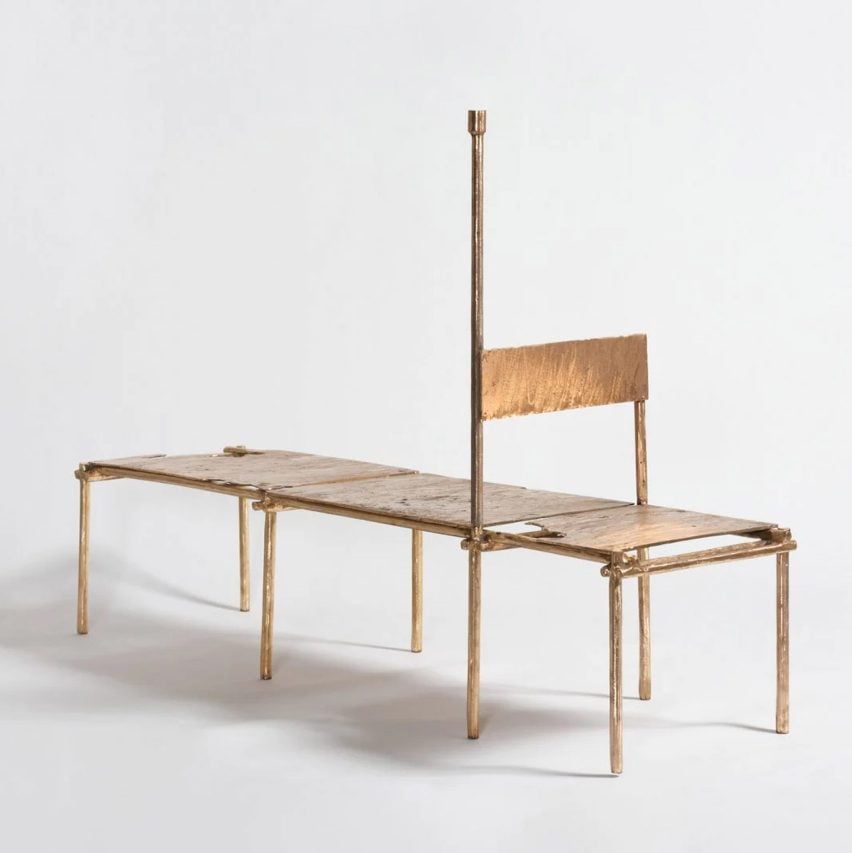
Designer Nifemi Marcus-Bello embraced the difficulties of working with copper in Nigeria, where the material is mined but rarely sold, to make his latest metal furniture collection for Los Angeles gallery Marta.
Titled Whispers of a Trail, the collectible furniture collection is the third chapter in Marcus-Bello’s Oríkì series, in which he examined three materials in turn: first bronze then aluminium and now copper.

With copper, he wanted to focus on a metal that would elucidate a common theme in Nigeria and the region – that raw materials are often mined here but then shipped overseas for refinement, meaning local companies and people miss out on most of the economic benefit.
“Growing up in Nigeria, you hear about the oil and gas industry, where oil is extracted but never refined in Nigeria,” Marcus-Bello told Dezeen. “It’s refined abroad somewhere in America or Europe and then sold back to us. So petrol in itself is extremely expensive.”

“I wanted to find a material that was prominent in Lagos or a city that I know well and understand why it is being extracted, refined abroad, and then we’re rarely using them or not able to use the raw material,” he continued.
Oríkì (Act III): Whispers of a Trail features a daybed, lamp, side table and headrest, all made from sand casted copper. Procurement became part of the process of making the objects, as Marcus-Bello found it was even harder than he expected to source copper to work with.
He couldn’t acquire virgin copper anywhere in Lagos, so he tried approaching mines directly. When they wouldn’t engage with him, he redirected his attention to scrap copper, visiting the city’s biggest scrapyard and speaking to the litter pickers who pull copper out of e-waste.

He thought he might be able to buy directly from them, but they told him they weren’t allowed to sell and directed him to another man, who Marcus-Bello tracked down and approached next.
“And he goes, ‘Oh, actually, I’m not the guy that sells; I’m the guy that sorts’,” said Marcus-Bello.
The designer estimates he followed a chain of 12 people to eventually find some suppliers who were willing to sell scrap copper to him.

The next challenge came with using the material, since its scarcity meant there was no local expertise. After casting the pieces for the first object in the collection, a side table, he found he couldn’t weld them together despite trying for two weeks with assistance from master welders.
He ended up selling part of the tonne of copper he had procured in order to buy bronze and make a copper alloy to join the pieces.
His design for the four objects in the collection reflects his experience in procuring the copper, with most of them referencing traditional furniture typologies used by African farmers and nomadic people.
“I think I have a weird sense of humour,” said Marcus-Bello. “The reason why I chose these forms is because of the nomadic feel of finding these guys. I felt like they were farming the copper, if that makes sense.”
Both the daybed and headrest are inspired by furniture used by farmers – the former a simple bed formed by laying sticks and leather over a base, and the latter by a multifunctional item on which a person can either sit or rest their head to keep it off the ground while sleeping.
The designer chose to make the lamp because of the material’s wide use in electrical equipment. The candlestick that protrudes from the daybed is a reference to that same connection.

Marcus-Bello previously lived in Zambia, which contains part of Central Africa’s Copperbelt mining region and put copper on his radar.
However, the same pattern of exploitation plays out with a wide range of natural resources, he points out, from the cobalt that ends up in expensive electronics to the cocoa that goes into chocolate bars.
“There’s loads of cocoa in Nigeria,” Marcus-Bello said. “It’s extracted but then refined in Rotterdam. Everyone’s having Cadbury chocolate in Lagos but there are no local chocolate manufacturers.”
Marcus-Bello hopes that Oríkì (Act III): Whispers of a Trail, currently on show at Marta gallery in LA, sparks a dialogue around these issues at home and abroad.

The two previous instalments of Oríkì similarly focused on unearthing the stories of materials that are closely linked to his home city of Lagos or its surrounds, whether through mining, manufacture or use.
He picked bronze because of the Benin Bronze Casters, the 800-year-old guild behind the famously looted Benin Bronzes, and aluminium because he wanted to document the processes of small makeshift foundries he discovered making car parts.
Marcus-Bello is known for working across a wide range of materials, which has included stainless steel in the form of a sculptural boat at Milan design week and bamboo in a pavilion for a Nigerian skateboarding company.
The photography by Erik Benjamins.
Oríkì (Act III): Whispers of a Trail is on show at Marta gallery in Los Angeles, California, from 21 February to 5 April 2025. See Dezeen Events Guide for more architecture and design events around the world.
The post Nifemi Marcus-Bello explores exploitation of Africa's natural resources with copper furniture appeared first on Dezeen.

